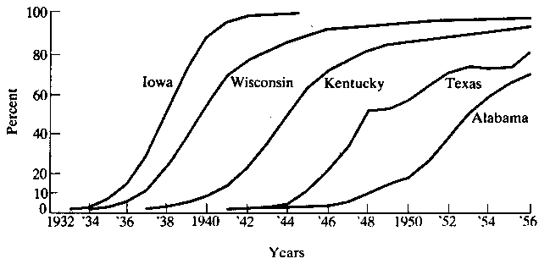|
|
Zvi Griliches: The Diffusion of Hybrid Corn Technology, 1957
By Nina Brown
|
|
Background
|

Griliches, Zvi (1930--1999)
Born in Lithuania, Griliches was a holocaust survivor who lost his parents in the Dachau concentration camp. Following the liberation of the camp in 1945, Griliches was sent to a British internment camp where he taught himself to read English. He later gained admittance to Hebrew University and then transferred to the University of California, Berkeley, where he majored in Agricultural Economics and earned an M.S. degree. He completed a PhD at the University of Chicago and joined the economics faculty there, later moving to Harvard University, where he taught until his death. Griliches was an innovative scholar who specialized in studying the economic impacts of technological innovation. He published numerous books and papers on subjects such as the impact of new technologies on industrial productivity and the rate of return to investments in higher education. As a member of the Boskin Commission appointed by Congress in 1996, he helped to develop new methods for measuring inflation. Griliches received the John Bates Clark Medal from the American Economics Association, given every two years to the best economist under the age of 40. He was elected to the National Academy of Sciences and was a Fellow of the American Association for the Advancement of Science and of the American Academy of Arts and Sciences.
|
|
Innovation
|
Griliches' dissertation, "Hybrid Corn: An Exploration in the Economics of Technological Change" (1957) was an effort to understand the economic processes underlying the diffusion of hybrid corn technology across the United States. The goal of Griliches' dissertation was to demonstrate that technological innovations could be analyzed from an economic perspective. He objected to existing economic theories that treated technological change as an exogenous factor unrelated to the larger economy.
In his dissertation Griliches traced the spread of hybrid corn varieties across the agricultural regions of the United States from 1932-1956. He tracked both the dates of availability of the new seeds and the times at which the new seeds were adopted by farmers in different states. He found that the hybrid corn varieties became available and were adopted by farmers in Iowa by 1934, but spread more slowly into other regions, reaching the deep South as late as 1946 [see illustration]. Griliches devised a logistic growth curve to explain the economic factors underlying this spatial pattern. The behavior of commercial seed producers was an important factor, he concluded. Seed producers carefully evaluated the market potential of each area before introducing hybrid varieties. As a result, the states of the Corn Belt, where farms were large and easily accessed by seed companies, were the first to receive the new products. In addition, many of the government funded agricultural research stations that developed the first hybrid corn varieties were located in the Corn Belt, and their research could be used to significantly lower the cost of developing commercial hybrid corn varieties for the area. The decisions of farmers to use hybrid corn were also influenced by economic considerations. Griliches concluded that farmers evaluated the potential profitability of making the switch to hybrid corn by calculating the increase in yield per acre due to using hybrid corn minus the cost differences in the seed.
Griliches' research demonstrated that the adoption of new technologies like hybrid corn was not a single event, but was instead a series of developments that occurred at different rates across geographical space. His study shed light on the numerous individual decisions and economic calculations that drove new hybrid corn technology forward. Today, the economics of innovation has become an important topic within the fields of economics, business, and the sociology of science. And, as Griliches demonstrated, the analysis of spatial patterns in the diffussion of inovation can provide important clues to understanding economic processes.
|
 |
|
Percentage of total acreage planted with hybrid seed From: "Hybrid Corn: An Explanation in the Economics of Technological Change." In Technology, Education, and Productivity (1988). New York: Basil Blackwell, page 28.
|
|
|
|
|
Publications
|
"Hybrid Corn: An Exploration of the Economics of Technological Change." In Technology, Education and Productivity: Early Papers with Notes to Subsequent Literature. Pp. 27-52. (New York, Basil Blackwell, 1988 [1957]).
R&D, Patents and Productivity. Zvi Griliches, ed. (Chicago: University of Chicago Press, 1984).
Hedonic Price Indexes and the Measurement of Capital and Productivity: Some Historical Reflections. (Cambridge, MA : National Bureau of Economic Research, 1988).
Education, Human Capital, and Growth: A Personal Perspective. (Cambridge, MA: National Bureau of Economic Research, 1996).
Handbook of Econometrics. Zvi Griliches and Michael D. Intriligator, eds. (New York: North-Holland Publishing, 1994).
|
|
Related Works
|
Cooper, C.M. and J.A. Clark. Employment, Economics, and Technology: The Impact of Technological Change on the Labour Market. (New York: St. Martin's Press, 1982).
Mincer, Jacob. Human Capital Responses to Technological Change in the Labor Market. (Cambridge, MA : National Bureau of Economic Research, 1989).
Psacharopoulos, George. Returns to Investment in Education: A Global Update. (Washington, D.C.: World Bank, 1993).
Stoneman, Paul, ed. Handbook of the Economics of Innovation and Technological Change. (Oxford: Blackwell, 1995).
|
|
Links
|
http://post.economics.harvard.edu/faculty/zgrilich/
|
| |
|
|
Copyright © 2001 by Regents of University of California, Santa Barbara
Webmaster: , Page Author: Nina Brown
|
|
|